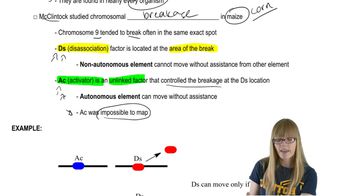Which of the following is the purpose of the GAL gene system?
Table of contents
- 1. Introduction to Genetics51m
- 2. Mendel's Laws of Inheritance3h 37m
- 3. Extensions to Mendelian Inheritance2h 41m
- 4. Genetic Mapping and Linkage2h 28m
- 5. Genetics of Bacteria and Viruses1h 21m
- 6. Chromosomal Variation1h 48m
- 7. DNA and Chromosome Structure56m
- 8. DNA Replication1h 10m
- 9. Mitosis and Meiosis1h 34m
- 10. Transcription1h 0m
- 11. Translation58m
- 12. Gene Regulation in Prokaryotes1h 19m
- 13. Gene Regulation in Eukaryotes44m
- 14. Genetic Control of Development44m
- 15. Genomes and Genomics1h 50m
- 16. Transposable Elements47m
- 17. Mutation, Repair, and Recombination1h 6m
- 18. Molecular Genetic Tools19m
- 19. Cancer Genetics29m
- 20. Quantitative Genetics1h 26m
- 21. Population Genetics50m
- 22. Evolutionary Genetics29m
13. Gene Regulation in Eukaryotes
GAL Regulation
Problem 21
Textbook Question
A modification of the two-hybrid system, called the one-hybrid system, is used for identifying proteins that can bind specific DNA sequences. In this method, the DNA sequence to be tested, the bait, is fused to a TATA box to drive expression of a reporter gene. The reporter gene is often chosen to complement a mutant phenotype; for example, a HIS gene may be used in a his⁻ mutant yeast strain. A cDNA library is constructed with the cDNA sequences translationally fused to the GAL4 activation domain and transformed into this yeast strain. Diagram how trans-acting proteins that bind to cis-acting regulatory sequences can be identified using a one-hybrid screen.
 Verified step by step guidance
Verified step by step guidance1
Understand the key components of the one-hybrid system: the bait DNA sequence (a cis-acting regulatory element) fused upstream of a minimal promoter such as a TATA box, which controls the expression of a reporter gene (e.g., HIS gene).
Recognize that the reporter gene is integrated into a yeast strain with a mutant phenotype (e.g., his⁻), so expression of the reporter gene can restore the wild-type phenotype, allowing growth on selective media.
Construct a cDNA library where each cDNA is fused to a known transcriptional activation domain (such as the GAL4 activation domain), creating fusion proteins that can potentially bind to the bait DNA sequence if they recognize it.
Transform the yeast strain containing the bait-reporter construct with the cDNA library plasmids, so that each yeast cell expresses a different fusion protein from the library.
Select for yeast cells that grow on selective media lacking histidine; these cells express the reporter gene because the fusion protein binds the bait DNA sequence, activating transcription. These positive clones identify trans-acting proteins that specifically bind the cis-acting bait sequence.
 Verified video answer for a similar problem:
Verified video answer for a similar problem:This video solution was recommended by our tutors as helpful for the problem above
Video duration:
2mPlay a video:
Was this helpful?
Key Concepts
Here are the essential concepts you must grasp in order to answer the question correctly.
One-Hybrid System
The one-hybrid system is a molecular biology technique used to identify proteins that bind specific DNA sequences. It involves fusing a DNA sequence of interest (bait) upstream of a reporter gene, which is activated only when a protein binds the bait. This method helps detect DNA-protein interactions by linking binding events to reporter gene expression.
Recommended video:
Guided course

Functional Genomics
Cis-acting and Trans-acting Elements
Cis-acting elements are DNA sequences, like promoters or enhancers, that regulate gene expression on the same DNA molecule. Trans-acting factors are proteins, such as transcription factors, that bind these cis-elements to modulate transcription. Identifying trans-acting proteins that bind specific cis-elements is key to understanding gene regulation.
Recommended video:
Guided course

Discovery
Reporter Gene and Selection in Yeast
Reporter genes produce easily measurable products, allowing detection of protein-DNA interactions. In yeast one-hybrid assays, reporter genes like HIS complement mutant strains lacking histidine synthesis, enabling growth only if the reporter is activated. This selection links protein binding to survival, facilitating identification of DNA-binding proteins.
Recommended video:
Guided course

Natural Selection
Related Videos
Related Practice
Multiple Choice
448
views
1
rank


